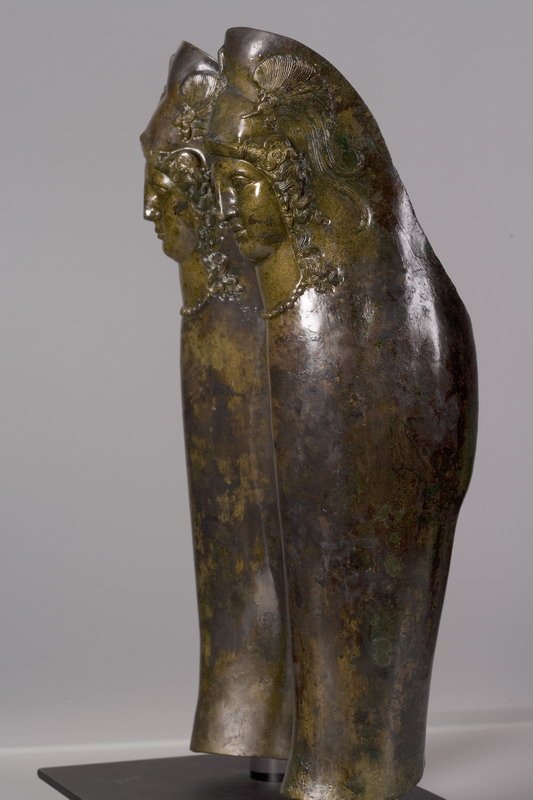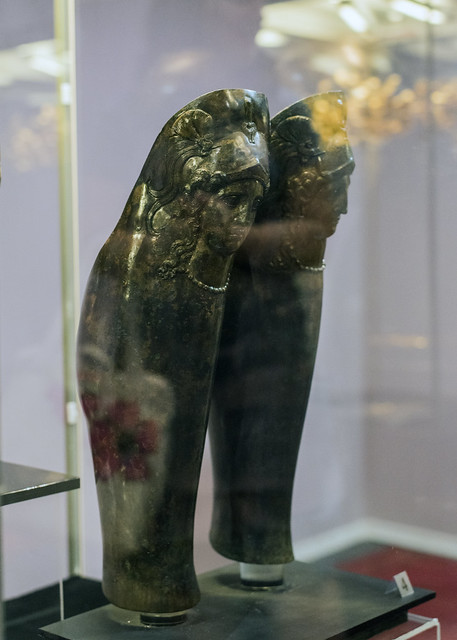Introduction
The discovery of the Thracian bronze greaves (shin guards) dating from approximately 400-300 BC has provided invaluable insights into the martial and spiritual traditions of the ancient Thracians. Found in the Goliamata Kosmatka mound near Kazanluk, Bulgaria, during the 2004 excavations, these greaves were part of the burial site of Seuthes III, the king of the Odryssian kingdom—one of the most powerful Thracian states. Accompanied by a wealth of artifacts, including a helmet inscribed with Seuthes III’s name, a golden wreath, a sword, armor, horse gear, and an amphora filled with wine, these findings highlight the opulence and warrior culture of Thracian royalty.
The Significance of the Greaves
Among the treasures, the bronze greaves stand out due to their intricate artistic and symbolic detailing. They are particularly notable for the depiction of a warrior goddess, which has sparked significant scholarly debate. Initially, historians debated whether the figure represented Minerva (Athena), the Thracian Great Goddess, or even Penthesilea, the legendary queen of the Amazons. However, further analysis strongly suggests that the goddess depicted is Bendida (Bendis), the Thracian deity associated with the hunt, the moon, and unifying forces in Thracian culture.

Who Was Bendida?
Bendida was a widely revered deity among the Thracians and later gained prominence in other regions, including Attica. Her worship in Athens became so influential that it was integrated into local festivals, most notably the Bendideia, a celebration that included unique torchlight horse races. The Greek philosopher Plato referenced this festival in The Republic, indicating its significance in ancient Greek society:
“You haven’t heard that there is to be a torchlight race this evening on horseback in honor of the Goddess?” “On horseback?” said I. “That is a new idea. Will they carry torches and pass them along to one another as they race with the horses, or how do you mean?” “That’s the way of it,” said Polemarchus, “and, besides, there is to be a night festival which will be worth seeing.”
The Artistic and Cultural Interpretation
The imagery on the greaves aligns closely with common representations of Bendida. She is often depicted holding a spear and wearing a distinctive Thracian, Phrygian, or Scythian cap. The detailing on the greaves suggests a deliberate effort to convey the goddess’s divine protection and warrior-like attributes, reinforcing the notion that Seuthes III, as a ruler, was under her divine favor.

Symbolism of the Name
The name Bendida is believed to derive from the Proto-Indo-European root bʰendʰ-, meaning “to bind, unite, or combine.” This linguistic origin aligns with her perceived role as a unifier of warriors and a bridge between Thracian and Greek religious traditions.
The Thracian Legacy in Ancient Warfare and Religion
The Thracians were known for their fierce warrior culture and sophisticated burial rites. The presence of richly adorned greaves in Seuthes III’s tomb suggests that they were not merely protective armor but also objects of great ceremonial and religious importance. The craftsmanship of these greaves indicates the advanced metallurgical skills of Thracian artisans, as well as their deep-rooted belief in the divine protection granted by their gods.

Conclusion
The discovery of the Thracian bronze greaves has shed light on the complex interplay of warfare, religion, and artistic expression in ancient Thrace. These artifacts not only highlight the martial prowess of Seuthes III and his people but also emphasize the cultural connections between Thracian and Greek societies through the shared veneration of deities like Bendida. As research continues, these greaves remain a profound testament to the spiritual and military landscape of one of antiquity’s most formidable civilizations.

